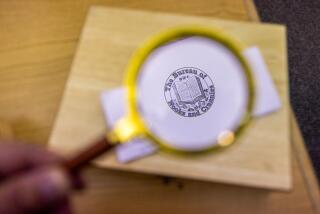Libraries Are Shelter for Homeless as Well as Books
Libraries often make efforts to serve certain groups of patrons, adding special rooms for children or acquiring large-print books for senior citizens. But the renovations taking place at the Santa Ana Central Library signal the acceptance of a less traditional clientele: the homeless.
The changes include moving reading lounges and restrooms within view of the main circulation desk and relocation of the magazine section--a popular spot for the homeless--into open view. When the library reopens in a few weeks, it will be without the secluded alcove near a fireplace that was a favorite napping spot for homeless people.
âThe increased visibility and other changes probably wonât have an effect on the number of homeless people who use the library,â branch director Robert Richard said, âbut visual contact is important in keeping touch with whatâs going on with all patrons.â
Though Orange County libraries do not have the big-city problem of being overrun by homeless people who use libraries as daytime shelters, they are an increasingly popular sanctuary for some local street people.
And county libraries are coming to accept the homeless as a special kind of patron, devising book borrowing programs for homeless children, teaching librarians how to deal with street people and passing out flyers for local soup kitchens.
âThey have to be treated like any other patron as long as they use the library for what itâs for,â said Carmen Martinez, acting director of the county library system.
Librarians say those spending time in the library are mostly homeless men, not women or children. Some stay a few minutes, while others sit around in a comfortable chair with a newspaper or book laid out on their laps to snooze for hours. They use the restrooms for sponge baths or to wash clothes.
Some âregularsâ do actually enlist the help of librarians to find particular materials or use the on-line computer to conduct book searches.
Tom, 52, has been homeless since he moved to Anaheim three years ago from Connecticut in hope of finding work. He spends hours at the Anaheim Central Library scanning want ads.
When he doesnât find anything, Tom said, âI like reading the paper or looking at books. . . . Itâs safe in here.â
George Ellithorpe, who said he has been homeless for the past eight years, is a regular at the Santa Ana Central Library.
âI go in there to get warm, and then I get bored and I go to sleep,â said Ellithorpe, 62, a former carpenter and cabinetmaker.
While the library is closed for renovations, he has been spending days on a wooden bench in Civic Center Plaza.
âIn the summer the library is the only place to go to cool off,â Ellithorpe said. âItâs the only building we can go in that has air conditioning. Street people arenât allowed to do a lot of things.â
Many libraries provide staff members with informal training about how to deal with homeless people, especially those who bother other patrons. Several directors said they have had to call police when someone became verbally or physically abusive upon being asked to leave or to take belongings outside.
Library staff members have also intervened when they caught a street person panhandling or disturbing other patrons.
Most complaints about homeless people concern their body odor, library directors said. âWe canât make someone leave because of the way they smell,â Anaheim Central Library branch manager Kevin Moore said. âThereâs no law as far as I know against offensive bodily hygiene.â
Homeless people snoring during naps, particularly in reading rooms and quiet alcoves, has also prompted complaints.
In response to this and to stop the restroom bathing, most county libraries have increased floor patrols. Rules are also posted asking that bulky packs, bedrolls and shopping carts be left outside.
Many librarians are sympathetic to the homeless and stock flyers for local soup kitchens, help centers and other social services. A couple of county library branches are making special efforts to aid the homeless.
Huntington Beachâs Main Street branch shares a building with the Episcopal Service Alliance, which offers clothes, food and other aid. Branch manager Marianne MacKenzie said she tries to help when the service is not open by handing out bus passes and flyers provided by the group.
The Fullerton Public Library began an unusual program last year that caters to families with temporary addresses, who seem to spend much of the time moving from shelters to motels. Libraries usually require a permanent address to loan materials, but teachers complained that the policy discriminated against children who might need a book for school, director Al Milo said.
As sympathetic as they are, librarians realize that they are not a charity. âWeâre concerned because we care about people, but as an institution we have to identify our purpose,â said Judy Rohr, adult services coordinator for the Fullerton Public Library.
How libraries should deal with the homeless is becoming a national topic. The Public Library Assn. established a committee two years ago to collect and disseminate information about the issue. That panel will deliver its report when the group holds its annual meeting in the spring.
Committee chairwoman Jane Salisbury said the panel aims for a positive approach to the homeless issue: âWe want to change the perception that theyâre just loitering and instead raise consciousness that they are legitimate library patrons.â
Shannon Sands contributed to this story
* CHECK IT OUT: Books can be bought as well as borrowed at libraries. B3
More to Read
Sign up for Essential California
The most important California stories and recommendations in your inbox every morning.
You may occasionally receive promotional content from the Los Angeles Times.










